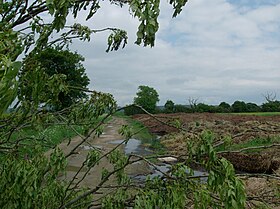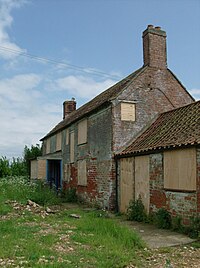Skinnand
Skinnand was a village, now vanished, in Kesteven, the south-western part of Lincolnshire. It was a small farming community standing nine miles south of Lincoln and eleven and a half miles north-west of Sleaford.
The village had a church and several houses. During the Civil War of 1642-1646 the church fell into ruins. Today only fields and one deserted farmhouse remain.[1]
- Location map: 53°6’23"N, 0°35’45"W
- Streetmap: SK941575
Contents
History
Middle Ages to the Civil War
Skinnand is recorded as "Schinende" in the Domesday Book of 1086, a name perhaps of Anglo-Saxon origin,[1] although others suggest the original name may have come from the Old Scandinavian word "skinnari," which means "skinner or tanner."[2]
The ancient parish of Skinnand was recorded as the smallest village in the Deanery of Longoboby in 1332. It had the lowest tax assessment, a population of around 40 and was predominantly based on agriculture.[3] The population of Skinnand stayed stable for many generations but, by 1563, only three of the original ten households remained. This decrease in numbers has been attributed, by some historians, to a reduction in arable farming and a rise in sheep production.[3]
Skinnand was classed as an ancient parish from the 11th to the 19th century, as it came "under the jurisdiction of a clergyman" and existed before 1597. Early records show that the Manor of Navenby and Skinnand was granted to the Dean and Chapter of Lincoln in 1292.[4] The land rent was used by Roger de Newton, the first incumbent of the chantry chapel at Harby, Nottinghamshire, to maintain the building: this followed the death of Queen Eleanor, wife of King Edward I, while on a visit to Lincoln. Eleanor died at de Newton's manor house at Harby in November 1290 and the chapel was erected in her honour.
Records show that the village of Skinnand had up to six houses before the Civil War of the seventeenth century, most built as small single-storey stone dwellings with thatched roofs. Two, however, were much larger. One was owned by a John Chester, which boasted four domestic rooms with 'upper chambers,' and the other was the parsonage. The parsonage included a hall, two parlours, a kitchen, buttery, milkhouse, brewhouse and stable. It also had three upstairs rooms, as well as an orchard, garden, yard and dovecote. It is believed the parsonage was pulled down, however, during the Civil War and, by the time of the Hearth Tax returns of 1665, there were just three houses in Skinnand.
Details about the Norman-built church of Skinnand are sketchy, although it was reputedly dedicated to St Matthew and burned down by Oliver Cromwell's forces in the 1640s.[5] Historical records certainly show that it had begun to fall into ruins in the 17th century, at around the time of the Civil War. The Glebe Terrier documents of 1700 recorded: "The church was in ruins, no house for the rector, more than this we find not, all the buildings being long since disappeared." Despite the disappearance of the church, parish registers reveal that services were still held throughout the 19th century, at the home of Skinnand man John Woolfitt. The Skinnand burial ground was also in use until 1911.
19th century
Skinnand was a village of just 12 people in 1801, according to the Census returns. The population did rise slightly over the next 100 years, to 30 in 1901, but by 1921 numbers were once again decreasing and the figure stood at 25. Census returns also reveal that most of the village men worked on the land as unskilled labourers.[6] The children of these poor labourers attended school at Wellingore, just south of Navenby, and at Carlton-le-Moorland and Bassingham - each village several miles walk away.[5]
As a result of the 1834 Poor Law Amendment Act, the parish became part of the Lincoln Poor Law Union and, by the mid-19th century, Skinnand was a struggling parish in the Higher division of the Boothby Graffoe Wapentake. According to the Institute of Historical Research, it consisted of 636 acres, of which 40 were arable and the rest "old pasture and meadow."[7] The records add: "The living is a discharged rectory, valued in the King's books at £5. 13. 11½.; net income, £85; patron, S. Nicholls, Esq. The church is in ruins." Skinnand was also the main residence in the area for the Woolfitt family, land owners and clergy at the church. Headstones for members of the Woolfitt family, including local Methodist minister John Woolfitt, can be found in the remains of the cemetery.
The History of the County of Lincoln, a book written by Thomas Allen in 1834, states:[8]
The Wapentake of Boothby Graffoe is bounded on the north by Lawress wapentake; on the east by Lincoln Liberty and Langoe wapentake; on the south by Loveden wapentake; and on the west by Nottinghamshire. It is separated into High and Low Divisions. Through this wapentake a Roman road passes from Lincoln to Brough, a village just without the bounds of the county. The High division of the wapentake of Boothby Graffoe contains the villages of Boothby, Coleby, Harmston, Navenby, Skinnard, Swinethorpe, Welbourn and Wellingore. Navenby used to be a market town. The living is a rectory, rated at £17 10s. 0d., and is in the patronage of the Master and Fellows of Christ Church College, Cambridge.
In 1871 it was recorded that "just a few stones remain to mark the location" of the old church. In the same year, the Census showed that the parish now consisted of only three farms, all belonging to Mr S. Nicholls of London. Other surnames in the parish at that time included Clawson, Burt and Picker.[5]
20th century
The 1911 Census shows that the population of Skinnand was once again in decline at the turn of the 20th century, with just 28 people living in the village. Most were tenant labourers as, by 1913, William Grant of Grimsby was the principal landowner. The village was occupied for just a few more years, however, before the final families moved out. Today, just a boarded up old farm house stands where the thriving community of Skinnand once was.[5]
Geography
The civil parish of Skinnand lies close to the old Roman Ermine Street, known locally as High Dyke. The road runs between the neighbouring villages of Boothby Graffoe, Navenby and Wellingore and covers more than 2,100 acres.[9]
The Viking Way, a 147-mile footpath between the Humber Bridge at the northern edge of Lincolnshire and Oakham in Rutland, also passes through the parish.[10]
Skinnand stood just below the ridge of Jurassic limestone called the Lincoln Edge or 'Lincoln Cliff'. The small cliff is one of only a few hills in Lincolnshire.[11]
Outside links
| ("Wikimedia Commons" has material about Skinnand) |
- Skinnand, Lincolnshire: A Vision of Britain
References
- ↑ 1.0 1.1 Farmland Skinnand: Archaeology UK, 2007
- ↑ Mills, Anthony David: 'A Dictionary of British Place-Names' (Oxford University Press, 2003) ISBN 978-0-19-852758-9
- ↑ 3.0 3.1 David Merchant (2002). "About Skinnand Village". Archived from the original on 2008-06-09. https://web.archive.org/web/20080609192340/http://www.oden.co.uk/skinnand/villhist.htm. Retrieved 2008-05-30.
- ↑ Massingberd, W.O. (1905). The Lincolnshire Sokemen, The English Historical Review. Oxford University Press. pp. 699–703.
- ↑ 5.0 5.1 5.2 5.3 Information on Skinnand from GENUKI
- ↑ Vision of Britain (2007). "Skinnand Through Time". http://www.visionofbritain.org.uk/data_theme_page.jsp?u_id=10450780&c_id=10001043&data_theme=T_SOC. Retrieved 2008-05-30.
- ↑ Samuel Lewis: 'A Topographical Dictionary of England (1848)
- ↑ Allen, Thomas: 'The History of the County of Lincoln' (J. Saunders. Jnr, 1834) page 79
- ↑ Great Britain Historical GIS Project (2007). "Navenby through time". A Vision of Britain Through Time. http://www.visionofbritain.org.uk/data_theme_page.jsp?u_id=10444305&data_theme=T_POP. Retrieved 2008-03-30.
- ↑ "Cliff-edge villages offer a dramatic and historic setting". Horncastle News (Johnston Press Digital Publishing). 2006-11-23. http://www.horncastlenews.co.uk/walk-of-the-month/Cliffedge-villages-offer-a-dramatic.1894176.jp. Retrieved 2008-03-30.
- ↑ Cliff Villages (Lincoln) U3A (2006). "Why Cliff Villages?". http://www.cliffvillageslincolnu3a.org.uk. Retrieved 2008-03-30.
- Skinnand: Lincs to the Past


